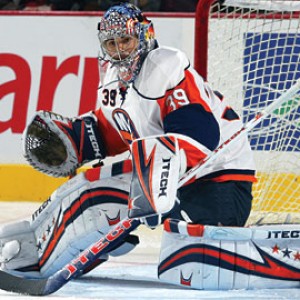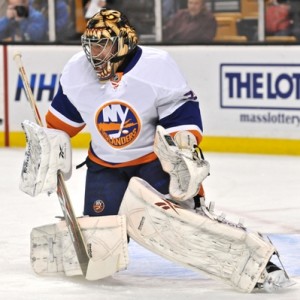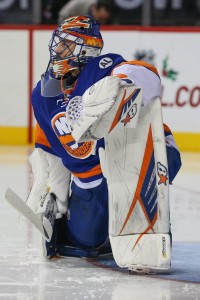After years of subpar play between the pipes, the New York Islanders have finally found a goaltending tandem that is helping the team win games.
Behind Jaroslav Halak and Thomas Greiss, the Isles have climbed up to third place in the Metropolitan Division and fourth overall in the Eastern Conference, picking up points in eight of their past ten games.
For GM Garth Snow and coach Jack Capuano, the revelation in goal this season – heck, the revolution in goal this season – has to feel quixotic. Otherworldly. But they can pinch themselves and rest assured that it’s all very real.
And let’s remember: any skepticism on their behalf wouldn’t be misguided. Especially in Snow’s case. This organization has been so snakebitten in net under his direction, the Isles and their fans almost seemed to accept inferior goaltending as a fact of NHL existence. As if it couldn’t be any other way.

There was the whole Rick DiPietro debacle of course – by the way, the Islanders still owe him $1.5 million per year through 2029 (!!!!) – but their problems in goal go beyond a star-crossed draft pick and an awful contract. Quite simply, no one the team has employed to man the crease in the past 15 years has been all that good.
This was especially true before Halak arrived in the 2014 offseason. The situation had become so bleak, in fact, that Evgeni Nabokov, who failed to record a top-20 save percentage over three seasons with the Isles, often times felt like the Masked Deliverer. Nabokov was fine; he was no savior.
Recent Statistics
It is easy – and convenient – to point to a goalie’s save percentage as his defining statistic. The problem with save percentage, though, is that it assumes goalies compete on a level playing field, that every shot sent towards goal has an equal chance of going in. In reality, shooting percentage varies drastically depending on location, and a goalie that faces 15 shots from the slot versus one that faces 15 shots from the point is at an obvious disadvantage. Save percentage doesn’t account for this.
Adjusted save percentage does. By taking into account the quality of shots a goalie faces, it’s a more accurate indication of his performance. To wit: goalies that face an above-average percentage of high-quality shots aren’t punished, while goalies that face a below-average percentage of high-quality shots aren’t rewarded. In effect, it levels the playing field.

In the 2011-12 season, the Isles split time between Nabokov and Al Montoya. Nabokov’s adjusted save percentage (AdSv%) was .917, Montoya’s was .905. Out of goalies with at least ten starts that season (this filter applies for all stats listed here), Nabokov’s AdSv% ranked 37th and Montoya’s 54th. And it was this standard that the Islanders’ goalies – Nabokov, Anders Nilsson, Kevin Poulin, Chad Johnson – continued to meet for the next three years.
The team’s cumulative 5 v. 5 save percentage between 2011-12 and 2013-14 was never better than .911 and never ranked higher than 27th. No matter the combination of goalies the Islanders deployed, the collective results were the same.
Here’s where things get interesting. Last year, with the superb Jaroslav Halak taking over in net, the Isles’ goaltending stats… hardly improved. Halak’s AdSv% of .927 ranked just 22nd in the league, while backup Chad Johnson ranked 56th at .901. As a team, the Isles posted a cumulative 5 v. 5 save percentage of .915 that ranked 27th overall.
A year later, the team boasts a cumulative 5 v. 5 save percentage of .933, good for ninth in the league.
So…
What Happened?
Thomas Greiss arrived. Halak got better. As simplistic as that sounds, there simply isn’t an analytical answer in the numbers.
Because it gets more interesting still: Last season the Islanders posted a scoring chances for percentage (SCF%) of 53.1, the fifth best mark in the league. Meanwhile, their high-danger scoring chances for percentage (HSCF%) was 55.5, the best mark in the league. In short, the Isles were attacking the opposition’s net while protecting their own more efficiently than any team in the league…and their cumulative 5 v. 5 save percentage was flat-out ugly.
By comparison, this year’s Islanders’ SCF% is 49.7, 19th in the league, and their HSCF% is 49.3, 18th in the league. And despite surrendering more scoring chances and more high-danger scoring chances per game than a season ago, their goaltending numbers have vastly improved.
So it’s not as if the Islanders’ goalies are suddenly being insulated by far better team play. And it’s not as if they’re posting great numbers by making easy saves. So what happened?
Let’s say it again: Thomas Greiss arrived. Halak got better.
Islanders Goaltending This Season
The emergence of Greiss has made a tremendous difference. For as bad as the Isles’ starting goalies have been in the recent past, the backups have been even worse. Here is where the Islanders’ second-string goalies rank in AdSv% each of the past four seasons: 2011-12 – 54th; 2012-13 – 46th; 2013-14 – 45th; 2014-15 – 58th.
That last number is particularly galling, and explains a good portion of the team’s statistical improvement in goal this season. Despite starting just 19 games last season compared to Halak’s 59, Johnson was abnormally bad enough to considerably drag down the duo’s numbers. Halak wasn’t exactly Georges Vezina himself, but even average numbers on Johnson’s behalf would have painted a far brighter cumulative picture.

This all serves to make Greiss’ performance this season even more satisfying. For the Isles’ backup hasn’t simply been serviceable; he’s been terrific. (He’s more than Greiss; he’s ggggrrrrrrrreat!!) In 13 starts so far, the 29-year-old German has posted an AdSv% of .938 – 7th in the league – while compiling a record of 8-3-2. It remains to be seen, of course, whether he can sustain this pace for the duration of the season, but so far Greiss has given the Islanders a tremendous boost in goal.
His counterpart, Halak, has been even better. Maybe he feels more comfortable after a year on Long Island. Maybe he loves Brooklyn. Maybe he’s blazing a different career path. Whatever the reason for his improved play this season, one thing’s for sure: Halak is entering the goaltending elite. His .944 AdSv% ranks 4th in the league; compare that to his unadjusted save percentage of .934, and you get an idea of the kind of high-level saves he’s being asked to make.
The question for Halak is the same one for Greiss. Can he keep it up?
And the answer is simple: we’ll see.
For now though, the Isles should celebrate the transformation that’s taken place between the pipes. They’ve certainly endured enough frustration to deserve it.
Note: all stats are courtesy of war-on-ice.com